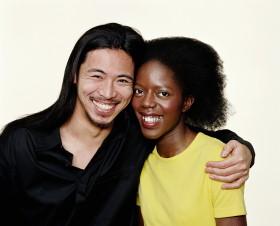Incorporate cool ideas into your wedding by adding a touch of your ancestral culture.
Here are great ways to have a cross or multi-cultural wedding.
Here are great ways to have a cross or multi-cultural wedding.
With the trend toward personalizing weddings, one of the strongest ways is to incorporate traditions based on the ethnic and cultural heritage of the couple.
African
"Jumping the broom" is one of the most popular additions to the modern African-American wedding. The practice began with enslaved Africans denied the right to formally marry. Also, the broom is believed held spiritual significance for many African peoples, representing the beginning of homemaking for a couple. For the Kgatla people of southern Africa, it was customary, for example, on the day after the wedding for the bride to help the other women in the family to sweep the courtyard clean, thereby symbolizing her willingness and obligation to assist in housework at her in-laws' residence until the couple moved to their own home.
Beautiful kente cloth is a colorful alternative to traditional wedding attire. You'll find good ideas online at Nigerian Fabrics and Fashions online. Many tux retailers also provide a vest in a Kente print.
Cowrie shells, which are believed to encourage fertility, are worn in bridal necklaces and to trim gowns and headpieces.
Give the perfect gift
Hispanic
Padrinos and madrinos are the wedding sponsors, who promise financial and spiritual aid.
In Mexico, a "lasso" of a very large rosary is wound around the couple's shoulders and hands during the ceremony to show the union and protection of marriage.
It's told that in Puerto Rico, a bridal doll in a dress that replicates the bridal gown, is placed on the head table or the cake table. Little momentos called capias are pinned to the doll. During the reception, the bride and groom will walk to each person to thank them for their presence at the nuptials and for their well wishes. Each person is pinned with a capia.
Caribbean
Slices of dark wedding fruitcake laced with rum are mailed to all friends and relatives unable to attend the reception (almonds) in life.
African
"Jumping the broom" is one of the most popular additions to the modern African-American wedding. The practice began with enslaved Africans denied the right to formally marry. Also, the broom is believed held spiritual significance for many African peoples, representing the beginning of homemaking for a couple. For the Kgatla people of southern Africa, it was customary, for example, on the day after the wedding for the bride to help the other women in the family to sweep the courtyard clean, thereby symbolizing her willingness and obligation to assist in housework at her in-laws' residence until the couple moved to their own home.
Beautiful kente cloth is a colorful alternative to traditional wedding attire. You'll find good ideas online at Nigerian Fabrics and Fashions online. Many tux retailers also provide a vest in a Kente print.
Cowrie shells, which are believed to encourage fertility, are worn in bridal necklaces and to trim gowns and headpieces.
Give the perfect gift
Hispanic
Padrinos and madrinos are the wedding sponsors, who promise financial and spiritual aid.
In Mexico, a "lasso" of a very large rosary is wound around the couple's shoulders and hands during the ceremony to show the union and protection of marriage.
It's told that in Puerto Rico, a bridal doll in a dress that replicates the bridal gown, is placed on the head table or the cake table. Little momentos called capias are pinned to the doll. During the reception, the bride and groom will walk to each person to thank them for their presence at the nuptials and for their well wishes. Each person is pinned with a capia.
Caribbean
Slices of dark wedding fruitcake laced with rum are mailed to all friends and relatives unable to attend the reception (almonds) in life.
Indian
The groom's brother sprinkles flower petals ( to ward off evil) on the bridal couple at the end of the ceremony. So often flowers are the perfect way to say exactly what we are feeling. This is a way these delicate blooms protect!
Japanese
The traditional Japanese tea ceremony honors and thanks the parents at the wedding.
Drinks of sake are exchanged between members and close relatives of the both families to signify their union through the wedding.
Red and white are a happy color combination in Japan, as abundantly used in a wedding. The soup may have ingredients in such color scheme and ice cream may be served in the same color combination.
Korean
Ducks are included in the wedding procession because ducks mate for life. How truly romantic!
Malaysian
Each wedding guest is given a beautifully decorated hard-boiled egg, a symbol of fertility. Throughout history and in many cultures eggs play an important role in relationships.
Pakistani
This Pakistani custom is so very festive. It reminds us just how much fun this sacred union between two souls can be. The bride's family strings hundreds of brightly colored lights around the house in anticipation of the wedding.
Vietnamese
There are two wedding celebrations, one party given by the bride's family and the other by the grooms. This country's culture is so vibrant. Every aspect of its art, music, and ceremonies are swathed in elegance.
Spanish
Traditionally, the groom wears a tucked shirt, embroidered by the bride.
It is a tradition for Spanish brides to carry orange blossoms in their bouquet. Seville oranges are world-renowned and have a lovely scent. It's not unlikely that Spanish brides of yore took advantage of their beauty to complement their bridal outfits.
The groom gives thirteen coins (the giving of monedas or arras) to the bride, symbolizing his ability to support and care for her. During the ceremony, she carries them in a special purse, or a young girl carries them on a pillow or handkerchief.
The groom's brother sprinkles flower petals ( to ward off evil) on the bridal couple at the end of the ceremony. So often flowers are the perfect way to say exactly what we are feeling. This is a way these delicate blooms protect!
Japanese
The traditional Japanese tea ceremony honors and thanks the parents at the wedding.
Drinks of sake are exchanged between members and close relatives of the both families to signify their union through the wedding.
Red and white are a happy color combination in Japan, as abundantly used in a wedding. The soup may have ingredients in such color scheme and ice cream may be served in the same color combination.
Korean
Ducks are included in the wedding procession because ducks mate for life. How truly romantic!
Malaysian
Each wedding guest is given a beautifully decorated hard-boiled egg, a symbol of fertility. Throughout history and in many cultures eggs play an important role in relationships.
Pakistani
This Pakistani custom is so very festive. It reminds us just how much fun this sacred union between two souls can be. The bride's family strings hundreds of brightly colored lights around the house in anticipation of the wedding.
Vietnamese
There are two wedding celebrations, one party given by the bride's family and the other by the grooms. This country's culture is so vibrant. Every aspect of its art, music, and ceremonies are swathed in elegance.
Spanish
Traditionally, the groom wears a tucked shirt, embroidered by the bride.
It is a tradition for Spanish brides to carry orange blossoms in their bouquet. Seville oranges are world-renowned and have a lovely scent. It's not unlikely that Spanish brides of yore took advantage of their beauty to complement their bridal outfits.
The groom gives thirteen coins (the giving of monedas or arras) to the bride, symbolizing his ability to support and care for her. During the ceremony, she carries them in a special purse, or a young girl carries them on a pillow or handkerchief.
Category:



